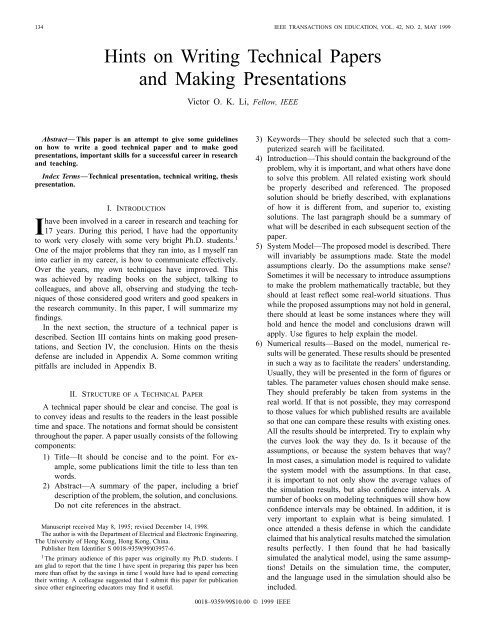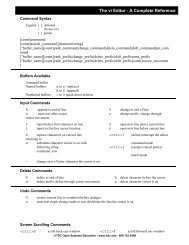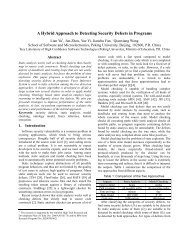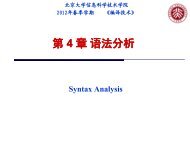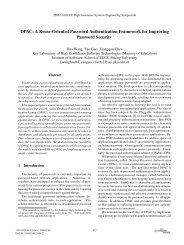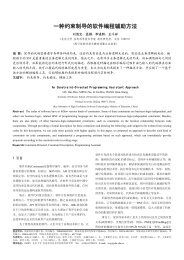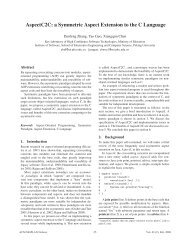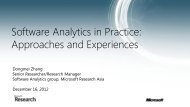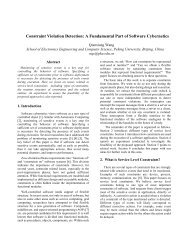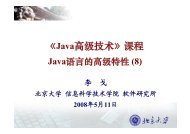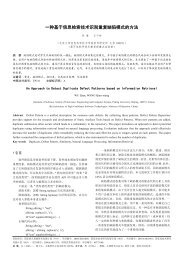Hints on Writing Technical Papers and Making Presentations
Hints on Writing Technical Papers and Making Presentations
Hints on Writing Technical Papers and Making Presentations
Create successful ePaper yourself
Turn your PDF publications into a flip-book with our unique Google optimized e-Paper software.
134 IEEE TRANSACTIONS ON EDUCATION, VOL. 42, NO. 2, MAY 1999<br />
<str<strong>on</strong>g>Hints</str<strong>on</strong>g> <strong>on</strong> <strong>Writing</strong> <strong>Technical</strong> <strong>Papers</strong><br />
<strong>and</strong> <strong>Making</strong> Presentati<strong>on</strong>s<br />
Victor O. K. Li, Fellow, IEEE<br />
Abstract— This paper is an attempt to give some guidelines<br />
<strong>on</strong> how to write a good technical paper <strong>and</strong> to make good<br />
presentati<strong>on</strong>s, important skills for a successful career in research<br />
<strong>and</strong> teaching.<br />
Index Terms—<strong>Technical</strong> presentati<strong>on</strong>, technical writing, thesis<br />
presentati<strong>on</strong>.<br />
I. INTRODUCTION<br />
Ihave been involved in a career in research <strong>and</strong> teaching for<br />
17 years. During this period, I have had the opportunity<br />
to work very closely with some very bright Ph.D. students. 1<br />
One of the major problems that they ran into, as I myself ran<br />
into earlier in my career, is how to communicate effectively.<br />
Over the years, my own techniques have improved. This<br />
was achieved by reading books <strong>on</strong> the subject, talking to<br />
colleagues, <strong>and</strong> above all, observing <strong>and</strong> studying the techniques<br />
of those c<strong>on</strong>sidered good writers <strong>and</strong> good speakers in<br />
the research community. In this paper, I will summarize my<br />
findings.<br />
In the next secti<strong>on</strong>, the structure of a technical paper is<br />
described. Secti<strong>on</strong> III c<strong>on</strong>tains hints <strong>on</strong> making good presentati<strong>on</strong>s,<br />
<strong>and</strong> Secti<strong>on</strong> IV, the c<strong>on</strong>clusi<strong>on</strong>. <str<strong>on</strong>g>Hints</str<strong>on</strong>g> <strong>on</strong> the thesis<br />
defense are included in Appendix A. Some comm<strong>on</strong> writing<br />
pitfalls are included in Appendix B.<br />
II. STRUCTURE OF A TECHNICAL PAPER<br />
A technical paper should be clear <strong>and</strong> c<strong>on</strong>cise. The goal is<br />
to c<strong>on</strong>vey ideas <strong>and</strong> results to the readers in the least possible<br />
time <strong>and</strong> space. The notati<strong>on</strong>s <strong>and</strong> format should be c<strong>on</strong>sistent<br />
throughout the paper. A paper usually c<strong>on</strong>sists of the following<br />
comp<strong>on</strong>ents:<br />
1) Title—It should be c<strong>on</strong>cise <strong>and</strong> to the point. For example,<br />
some publicati<strong>on</strong>s limit the title to less than ten<br />
words.<br />
2) Abstract—A summary of the paper, including a brief<br />
descripti<strong>on</strong> of the problem, the soluti<strong>on</strong>, <strong>and</strong> c<strong>on</strong>clusi<strong>on</strong>s.<br />
Do not cite references in the abstract.<br />
Manuscript received May 8, 1995; revised December 14, 1998.<br />
The author is with the Department of Electrical <strong>and</strong> Electr<strong>on</strong>ic Engineering,<br />
The University of H<strong>on</strong>g K<strong>on</strong>g, H<strong>on</strong>g K<strong>on</strong>g, China.<br />
Publisher Item Identifier S 0018-9359(99)03957-6.<br />
1 The primary audience of this paper was originally my Ph.D. students. I<br />
am glad to report that the time I have spent in preparing this paper has been<br />
more than offset by the savings in time I would have had to spend correcting<br />
their writing. A colleague suggested that I submit this paper for publicati<strong>on</strong><br />
since other engineering educators may find it useful.<br />
3) Keywords—They should be selected such that a computerized<br />
search will be facilitated.<br />
4) Introducti<strong>on</strong>—This should c<strong>on</strong>tain the background of the<br />
problem, why it is important, <strong>and</strong> what others have d<strong>on</strong>e<br />
to solve this problem. All related existing work should<br />
be properly described <strong>and</strong> referenced. The proposed<br />
soluti<strong>on</strong> should be briefly described, with explanati<strong>on</strong>s<br />
of how it is different from, <strong>and</strong> superior to, existing<br />
soluti<strong>on</strong>s. The last paragraph should be a summary of<br />
what will be described in each subsequent secti<strong>on</strong> of the<br />
paper.<br />
5) System Model—The proposed model is described. There<br />
will invariably be assumpti<strong>on</strong>s made. State the model<br />
assumpti<strong>on</strong>s clearly. Do the assumpti<strong>on</strong>s make sense?<br />
Sometimes it will be necessary to introduce assumpti<strong>on</strong>s<br />
to make the problem mathematically tractable, but they<br />
should at least reflect some real-world situati<strong>on</strong>s. Thus<br />
while the proposed assumpti<strong>on</strong>s may not hold in general,<br />
there should at least be some instances where they will<br />
hold <strong>and</strong> hence the model <strong>and</strong> c<strong>on</strong>clusi<strong>on</strong>s drawn will<br />
apply. Use figures to help explain the model.<br />
6) Numerical results—Based <strong>on</strong> the model, numerical results<br />
will be generated. These results should be presented<br />
in such a way as to facilitate the readers’ underst<strong>and</strong>ing.<br />
Usually, they will be presented in the form of figures or<br />
tables. The parameter values chosen should make sense.<br />
They should preferably be taken from systems in the<br />
real world. If that is not possible, they may corresp<strong>on</strong>d<br />
to those values for which published results are available<br />
so that <strong>on</strong>e can compare these results with existing <strong>on</strong>es.<br />
All the results should be interpreted. Try to explain why<br />
the curves look the way they do. Is it because of the<br />
assumpti<strong>on</strong>s, or because the system behaves that way?<br />
In most cases, a simulati<strong>on</strong> model is required to validate<br />
the system model with the assumpti<strong>on</strong>s. In that case,<br />
it is important to not <strong>on</strong>ly show the average values of<br />
the simulati<strong>on</strong> results, but also c<strong>on</strong>fidence intervals. A<br />
number of books <strong>on</strong> modeling techniques will show how<br />
c<strong>on</strong>fidence intervals may be obtained. In additi<strong>on</strong>, it is<br />
very important to explain what is being simulated. I<br />
<strong>on</strong>ce attended a thesis defense in which the c<strong>and</strong>idate<br />
claimed that his analytical results matched the simulati<strong>on</strong><br />
results perfectly. I then found that he had basically<br />
simulated the analytical model, using the same assumpti<strong>on</strong>s!<br />
Details <strong>on</strong> the simulati<strong>on</strong> time, the computer,<br />
<strong>and</strong> the language used in the simulati<strong>on</strong> should also be<br />
included.<br />
0018–9359/99$10.00 © 1999 IEEE
LI: HINTS ON WRITING TECHNICAL PAPERS 135<br />
7) C<strong>on</strong>clusi<strong>on</strong>s—This summarizes what have been d<strong>on</strong>e<br />
<strong>and</strong> c<strong>on</strong>cluded based <strong>on</strong> the results. A descripti<strong>on</strong> of<br />
future research should also be included.<br />
8) References—This should c<strong>on</strong>tain a list of papers referred<br />
to in the paper. If there is a choice, use a reference<br />
which is more readily available, i.e., if an author has<br />
published a c<strong>on</strong>ference versi<strong>on</strong> <strong>and</strong> a journal versi<strong>on</strong> of<br />
the paper, refer to the journal versi<strong>on</strong>. Research reports,<br />
internal memos, private corresp<strong>on</strong>dences, <strong>and</strong> preprints<br />
are usually hard to access <strong>and</strong> should be avoided as<br />
much as possible. By the way, journal editors tend to<br />
pick reviewers from the authors of the references cited<br />
in the submissi<strong>on</strong>.<br />
9) Appendix—Those materials which are deemed inessential<br />
to the underst<strong>and</strong>ing of the paper, but included for<br />
the sake of completeness. Sometimes, detailed mathematical<br />
proofs are put in the appendix to make the paper<br />
more readable.<br />
10) Figures—The figures may be placed immediately after<br />
they are referred to in the text, or placed at the end<br />
of the paper. Each figure should be readable without<br />
relying <strong>on</strong> the accompanying descripti<strong>on</strong> in the text.<br />
Thus, all symbols used in the figure should be explained<br />
in the figure legend. In additi<strong>on</strong>, do not make the figures<br />
<strong>and</strong> legends too small. Some figures may be reduced by<br />
the publisher before they are printed, <strong>and</strong> <strong>on</strong>e should<br />
ensure that the figures are still legible after reducti<strong>on</strong>.<br />
III. PRESENTATIONS<br />
Good presentati<strong>on</strong> skill is another prerequisite of a successful<br />
researcher. Good ideas will not be recognized unless they<br />
are effectively c<strong>on</strong>veyed to others. The presentati<strong>on</strong> should be<br />
rehearsed. This will help determine how many slides should<br />
be included in the presentati<strong>on</strong>. A good rule of thumb is <strong>on</strong>e<br />
slide per minute of presentati<strong>on</strong>, although that depends <strong>on</strong><br />
the individual speaker <strong>and</strong> the c<strong>on</strong>tents of the slide. Friends<br />
can be invited to the rehearsal, to ask questi<strong>on</strong>s, <strong>and</strong> to give<br />
suggesti<strong>on</strong>s for improvements. Some other points to note are:<br />
1) Visit the venue of the presentati<strong>on</strong> before the talk to<br />
get familiar with the layout of the room, <strong>and</strong> with the<br />
presentati<strong>on</strong> equipment.<br />
2) Do not dive into the viewgraphs immediately. Establish<br />
rapport with the audience by speaking to them for a<br />
couple of minutes before turning <strong>on</strong> the projector. What<br />
does <strong>on</strong>e talk about? One can summarize the results;<br />
explain how this talk relates to other talks in the sessi<strong>on</strong>;<br />
or how it relates to the keynote speech of the c<strong>on</strong>ference;<br />
or even tell a story of how <strong>on</strong>e got interested in this<br />
particular research topic, etc. Of course, this cuts into<br />
valuable presentati<strong>on</strong> time, <strong>and</strong> should not be overd<strong>on</strong>e.<br />
This will get the audience to focus <strong>on</strong> the speaker, rather<br />
than <strong>on</strong> the screen.<br />
3) Maintain eye c<strong>on</strong>tact with the audience throughout the<br />
talk. Talk to the audience, not to the viewgraphs. Address<br />
different parts of the room as the talk progresses. This<br />
means that the room should remain lit. Most overheads<br />
will still be readable with the room lit. It is a bad idea<br />
to speak in a dark room in which the <strong>on</strong>ly thing visible<br />
is the screen. The c<strong>on</strong>tact with the audience will be lost.<br />
4) Make sure the visual aids are readable. There are now<br />
a large number of presentati<strong>on</strong> tools available, ranging<br />
from h<strong>and</strong>written transparencies to multimedia presentati<strong>on</strong>s.<br />
The most popular <strong>on</strong>e is still transparencies<br />
projected <strong>on</strong>to a screen using an overhead projector.<br />
To determine if a transparency will be readable, the<br />
following test can be used. Put the transparency <strong>on</strong> the<br />
floor. It should be readable while the reader is st<strong>and</strong>ing.<br />
Using a bit of color to highlight important points is useful,<br />
although color transparencies are more expensive.<br />
With the increasing popularity of video projectors, it<br />
is expected that most presentati<strong>on</strong>s in the future will<br />
be made using a notebook PC c<strong>on</strong>nected to a video<br />
projector. It will be a good idea, however, to bring<br />
transparencies as a backup.<br />
5) Do not put too many ideas <strong>on</strong> the same transparency.<br />
The audience should be focusing <strong>on</strong> what the speaker<br />
has to say, rather than desperately trying to read the<br />
transparency.<br />
6) Everything <strong>on</strong> the slide should be explained.<br />
7) The presentati<strong>on</strong> does not have to follow the paper<br />
exactly. In a c<strong>on</strong>ference, 25 min will normally be<br />
allocated to each speaker, with 20 min for presentati<strong>on</strong><br />
<strong>and</strong> five minutes for questi<strong>on</strong>s <strong>and</strong> answers, <strong>and</strong> there<br />
is no way to include all the details of the paper. The<br />
goal should be to explain the importance of the work,<br />
the key ideas of the soluti<strong>on</strong>, <strong>and</strong> how it is different, <strong>and</strong><br />
hopefully, better than existing soluti<strong>on</strong>s. If the audience<br />
is interested, the paper is available in the c<strong>on</strong>ference<br />
proceedings. I have attended a presentati<strong>on</strong> in which the<br />
speaker just made transparencies of the paper <strong>and</strong> read<br />
the transparencies. Needless to say, this is unacceptable.<br />
8) On the other h<strong>and</strong>, the presentati<strong>on</strong> should not deviate<br />
too much from the paper either. I <strong>on</strong>ce attended a presentati<strong>on</strong><br />
in which the speaker said that the paper in the<br />
proceedings described old results, <strong>and</strong> then proceeded to<br />
deliver an altogether different paper. While this may be<br />
acceptable for informal workshops, it is not appropriate<br />
for c<strong>on</strong>ferences in which all of the submissi<strong>on</strong>s have<br />
been formally reviewed.<br />
9) Do not put too much mathematics <strong>on</strong> the slides. It is usually<br />
difficult to follow detailed mathematical derivati<strong>on</strong>s<br />
during a 20-min presentati<strong>on</strong>. Just enough mathematics<br />
should be presented to bring the key points across. The<br />
focus of the talk, in general, should be <strong>on</strong> the results.<br />
Use figures (plots) to bring the points across.<br />
10) There will usually be questi<strong>on</strong>s at the end of the<br />
presentati<strong>on</strong>. In fact, a good sessi<strong>on</strong> chair will usually<br />
prepare a couple of questi<strong>on</strong>s in advance just in case<br />
there are no questi<strong>on</strong>s from the audience. Some of<br />
these questi<strong>on</strong>s will hopefully have already been asked<br />
during the rehearsal, <strong>and</strong> should be h<strong>and</strong>led very well.<br />
If there is difficulty with a particular questi<strong>on</strong>, do not<br />
be overly defensive. While there may be showoffs<br />
who deliberately make very critical remarks just to<br />
show how good they are, in general most people are
136 IEEE TRANSACTIONS ON EDUCATION, VOL. 42, NO. 2, MAY 1999<br />
just trying to be helpful, <strong>and</strong> perhaps have not really<br />
understood some key points of the presentati<strong>on</strong>. If<br />
forced into a corner, <strong>and</strong> the sessi<strong>on</strong> chair does not<br />
come to the rescue, <strong>on</strong>e can escape by suggesting that,<br />
due to the lack of time, the discussi<strong>on</strong> will be c<strong>on</strong>tinued<br />
during the coffee break. Alternatively, a particularly<br />
difficult questi<strong>on</strong> posed by the audience can be turned<br />
into an idea for future work. By the way, it is always a<br />
good idea to repeat the questi<strong>on</strong> so the audience knows<br />
what is being asked. This will also ensure the questi<strong>on</strong><br />
is understood.<br />
11) It is a good idea to have a slide entitled “C<strong>on</strong>tributi<strong>on</strong>s,”<br />
especially in an interview presentati<strong>on</strong>. I have been to<br />
many interview talks at the end of which I was not<br />
sure what the speaker’s own c<strong>on</strong>tributi<strong>on</strong>s were. Never<br />
leave an interview committee in doubt about the nature<br />
of the c<strong>on</strong>tributi<strong>on</strong>s.<br />
IV. CONCLUSIONS<br />
Some thoughts <strong>on</strong> how to write good technical papers <strong>and</strong><br />
make good presentati<strong>on</strong>s are included in this paper. Hopefully,<br />
this will help the reader communicate ideas <strong>and</strong> results to the<br />
research community more effectively.<br />
APPENDIX A<br />
THESIS DEFENSE<br />
During the defense, the committee is going to look for:<br />
1) whether the c<strong>and</strong>idate has a very good underst<strong>and</strong>ing of<br />
the problem. That means <strong>on</strong>e should be c<strong>on</strong>versant in the<br />
relevant literature, <strong>and</strong> should explain how the proposed<br />
approach is different <strong>and</strong> better than existing work. In<br />
additi<strong>on</strong>, be ready to discuss how practical the work is,<br />
i.e., is it just an academic exercise or can <strong>on</strong>e actually<br />
use it in the real world? Are the assumpti<strong>on</strong>s realistic?<br />
2) the c<strong>on</strong>tributi<strong>on</strong> to the research community. This should<br />
be described in the abstract of the thesis, <strong>and</strong> repeated<br />
in the c<strong>on</strong>clusi<strong>on</strong>s. There should be at least <strong>on</strong>e slide<br />
entitled “C<strong>on</strong>tributi<strong>on</strong>s” in the defense presentati<strong>on</strong>.<br />
3) whether the c<strong>and</strong>idate has taken the time to digest the<br />
results generated. That is, whenever results are shown,<br />
such as a plot, or a table, be prepared to interpret<br />
the results. An intuitive explanati<strong>on</strong> of why the results<br />
look a particular way is especially helpful. If there are<br />
simulati<strong>on</strong> results, explain what is being accomplished<br />
with the simulati<strong>on</strong>, e.g., to justify a certain assumpti<strong>on</strong><br />
in the analytical model. Be sure to have explanati<strong>on</strong> for<br />
results which look strange, such as a curve which is not<br />
smooth, or a table with sudden jumps in values.<br />
4) suggested future work. List a few possible directi<strong>on</strong>s.<br />
Describe possible approaches to these problems, i.e.,<br />
dem<strong>on</strong>strate that these problems have been thought<br />
through.<br />
APPENDIX B<br />
COMMON ERRORS<br />
Over the years, I have collected a list of comm<strong>on</strong> mistakes:<br />
1) Hyphenated words—If the first word is used as an<br />
adjective, no hyphen is necessary, e.g., first generati<strong>on</strong>.<br />
If the first word is a noun, then you need to hyphenate,<br />
e.g., range-limited. If the sec<strong>on</strong>d word is a gerund, i.e.,<br />
the present c<strong>on</strong>tinuous tense of a verb, then it is not<br />
necessary to hyphenate, e.g., cell splitting.<br />
2) Normally, integers less than ten are spelled out. Thus<br />
<strong>on</strong>e will write “six cells” instead of “6 cells.” Integers<br />
larger than ten <strong>and</strong> fracti<strong>on</strong>al numbers are written in<br />
arabic digits, i.e., 12, 5.6, etc. Fracti<strong>on</strong>al numbers are<br />
c<strong>on</strong>sidered plurals. Thus, we will say “<strong>on</strong>e meter,” but<br />
“0.5 meters.”<br />
3) In technical papers, there are usually symbols, <strong>and</strong> the<br />
questi<strong>on</strong> arises as to which article to use in fr<strong>on</strong>t of<br />
symbols. Should we say a M/M/1 queue or an M/M/1<br />
queue? The rule is the same as in regular writing without<br />
symbols, i.e., if the word starts with a vowel, namely,<br />
the letters a, e, i, o, u, you will use the article “an”;<br />
otherwise, you will use “a.” However, we need to<br />
determine how the symbol is pr<strong>on</strong>ounced. In the case of<br />
M/M/1, we pr<strong>on</strong>ounce it “em-em-<strong>on</strong>e,” i.e., it starts with<br />
a vowel. Therefore, “an M/M/1” is correct. Compare this<br />
with a B-ISDN network. In this case, the B in B-ISDN<br />
is pr<strong>on</strong>ounced like “bee,” i.e., not a vowel.<br />
4) The first time a symbol is used, explain what it means,<br />
usually with the symbol in brackets, e.g., <strong>on</strong>e will<br />
write “Integrated Services Digital Network (ISDN).”<br />
Subsequently, use the symbol <strong>on</strong>ly. This is in keeping<br />
with the c<strong>on</strong>cept of c<strong>on</strong>ciseness.<br />
5) Try avoiding negative words like “not,” “un,” “n<strong>on</strong>,”<br />
etc., as well as double negatives such as “not invalid,”<br />
“not uninteresting” as much as possible. For example,<br />
use “invalid” instead of “not valid,” use “violating”<br />
instead of “not satisfying.”<br />
6) The phrase “a lot of” is used for uncountable objects,<br />
such as a lot of m<strong>on</strong>ey. Do not use it for countable<br />
objects, use the word “many” instead, i.e., say “many<br />
users” rather than “a lot of users.” The same goes for “a<br />
large amount.” It is also used for uncountable objects.<br />
7) Say “greatly improves” rather than “highly improves”<br />
or “largely improves.”<br />
8) Say “c<strong>on</strong>trary to” rather than “in c<strong>on</strong>trary to.” “C<strong>on</strong>trary<br />
to” is the same as “in c<strong>on</strong>trast to” or “as opposed to.”<br />
9) The words “work” <strong>and</strong> “research” are already in plural<br />
form. Thus we do not say “Existing works in this area<br />
” or “Prior researches ”<br />
10) Do not use abbreviated forms like “d<strong>on</strong>’t.” They should<br />
be spelled out.<br />
11) Avoid using multiple superlatives. Use “best” rather<br />
than “very best,” “optimal” rather than “most optimal.”<br />
12) The words “figure,” “table,” “theorem,” “lemma,” etc.<br />
may be used as proper or comm<strong>on</strong> nouns. Proper<br />
nouns must be capitalized. They are proper nouns when<br />
a number or some other attribute follows them. For<br />
example, we say, “Fig. 1 illustrates ” <strong>and</strong> “In this<br />
figure, we illustrate ”<br />
13) Do not start a sentence with “also.” Use words such as<br />
“Besides,” “Moreover,” “In additi<strong>on</strong>” instead.<br />
14) Say “comprises” or “c<strong>on</strong>sists of” rather than “comprises<br />
of.”
LI: HINTS ON WRITING TECHNICAL PAPERS 137<br />
15) Semi-col<strong>on</strong>s can be used to break up groups of objects.<br />
For example, “Set A comprises numbers 1, 2, 3; Set B<br />
comprises 4, 5, 6; Set C comprises 7, 8.”<br />
16) Avoid repeated usage. Say “ the storage required in<br />
the first case is greater than that in the sec<strong>on</strong>d case,”<br />
rather than “ the storage required in the first case is<br />
greater than the storage required in the sec<strong>on</strong>d case.”<br />
17) English <strong>and</strong> American spelling is sometimes different,<br />
i.e., “colour” versus “color.” Try to be c<strong>on</strong>sistent<br />
throughout the text.<br />
ACKNOWLEDGMENT<br />
The author would like to thank the people who have read<br />
earlier versi<strong>on</strong>s of this paper <strong>and</strong> gave useful suggesti<strong>on</strong>s.<br />
In particular, Dr. A. Choudhury of Lucent Technologies Bell<br />
Labs, Dr. I. Khan of Qualcomm, Inc., <strong>and</strong> Dr. S. Sengodan of<br />
Nokia Research Center gave comments in detail.<br />
Victor O. K. Li (S’80–M’81–SM’86–F’92) received the S.B., S.M., <strong>and</strong> Sc.D.<br />
degrees in electrical engineering <strong>and</strong> computer science from the Massachusetts<br />
Institute of Technology, Cambridge, in 1977, 1979, <strong>and</strong> 1981, respectively.<br />
He joined the University of Southern California (USC), Los Angeles,<br />
in 1981 as an Assistant Professor, <strong>and</strong> became Professor of Electrical<br />
Engineering <strong>and</strong> Director of the USC Communicati<strong>on</strong> Sciences Institute.<br />
Since Sept. 1, 1997, he has been with the University of H<strong>on</strong>g K<strong>on</strong>g as Chair<br />
Professor of Informati<strong>on</strong> Engineering in the Department of Electrical <strong>and</strong> Electr<strong>on</strong>ic<br />
Engineering, <strong>and</strong> Managing Director of Versitech Ltd., the University<br />
Company. He has published more than 200 technical papers <strong>and</strong> has lectured<br />
<strong>and</strong> c<strong>on</strong>sulted extensively around the world. His research interests include<br />
high-speed communicati<strong>on</strong> networks, pers<strong>on</strong>al communicati<strong>on</strong> networks, <strong>and</strong><br />
distributed multimedia systems.


